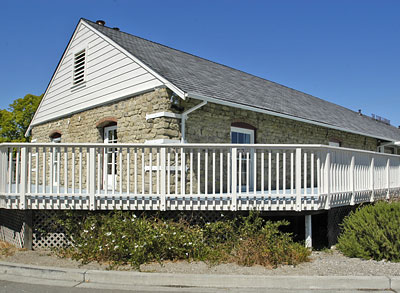National Register of Historic Places in Sonoma County
Petaluma and Santa Rosa Railway Powerhouse
238-258 Petaluma Avenue
Sebastopol
Built 1903
From its initial settlement in 1812 until the coming of the railroad in 1870, Sonoma County was dependent upon horse and wagon for transport of passengers and freight. Beginning in 1870, San Francisco & North Pacific Railroad (SF&NP) monopolized rapid land transit through the interior of the county. The SF&NP controlled access both north to Eureka and south to the ferry terminal at Tiburon.
The only alternative was the Southern Pacific lines running east from Santa Rosa to Napa Junction, Sacramento and the Midwest. The Sonoma County Board of Supervisors would not begin construction of a modern highway system until the 1920's, when automobiles became affordable to the American middle class.
Rapid urbanization led to the development of several horse-drawn intraurban transit systems in Santa Rosa and Petaluma. These urban horse-drawn trolleys accompanied the expansion of Sonoma County's two major cities outward as farmland was subdivided into new residential districts.
By 1903, the "leading citizens decided that the needs of this region, including development of the fruit and poultry industries, would best be served by the construction of an electric railroad linking the principal cities and providing easy access to the rich farm lands." The Petaluma and Santa Rosa Railway (P&SR) was incorporated on June 20th with one million dollars in capital stock.
P&SR purchased the major horse-drawn trolley lines as well as the paddlewheel steamer Gold which ran between Petaluma Landing and San Francisco. The steamboat was used to haul construction materials for the new rail line. Once the rail line was completed, Gold carried freight and passengers between Petaluma and San Francisco.
Land for the Sebastopol Power House was purchased on December 15, 1903, and constructiuon of the railroad began on April 5th, when the first spike was driven at Steamer Landing in Petaluma. The Sebastopol Power House, along with a wooden passenger depot and a freight storage structure, were completed by September.
In its first year, 1904, the P&SR put 29.92 miles of track in operation and purchased ten interurban passenger cars and five freight locomotives. The company's 1905 report provides the following commentary on expectations for service to the community:
. . . the railway traverses an agricultural district in the lower foothills of the Coast Range in Sonoma County and operates in a comparatively level country. The county served is rich and fertile, admirably adapted to the raising of fruits, berries, vegetables, poultry and stock, and for the manufacture of dairy products. The territory around Petaluma is principally poultry and grazing, and is known as the egg basket of the world. The territory from Sebastopol to Santa Rosa is orchard, vineyards, hop and grain fields. Principal cities are Petaluma, Sebastopol, Graton, Forestville, and Santa Rosa. Luther Burbank, the great horticulturist, has located his principal experimental farm near Sebastopol.
By 1905, P&SR had 35.81 miles of track.
P&SR developed ambitious plans for expansion to San Rafael, Dillon's Beach, Healdsburg, Sonoma and even Napa. However, the earthquake of 1906, the subsequent costs of repairing facilities damaged by the quake, competition from other carriers, and other business misfortunes prevented the realization of most of these plans.
In 1918, P&SR, in desperate financial condition, was reorganized.
In 1921, Sonoma County completed construction of a highway paralleling much of the company's lines, seriously affecting passenger revenue. Despite the loss of passenger traffic and increasing competition from the automobile, a new passenger and freight depot was built at Santa Rosa in 1927.
By 1931, P&SR faced three new problems: decreased demand as the nation-wide depression deepened; new competition for its Sonoma County farmers "due to the trucking of feed from the Sacramento and San Joaquin Valleys;" and the increasing impact of local trucking on its interurban freight business.
PS&R discontinued passenger service in 1932 but continued freight service continued through the war years without regard for equipment or track maintenance.
In 1946, with wartime controls and subsidies ended, the Golden Gate Bridge in operation, and postwar auto and truck competition supreme, P&SR shut down.
The trolley wire was removed from the Two Rock, Sebastopol, Forestville, and Santa Rosa branches between October and December 1946. Petaluma service was discontinued in March 1947, and the last of the trolley wires taken down by the end of May.
Adapted from the NRHP nomination dated 23 July 1991.

When we visited the building in 2004, it had been renovated and transformed into a bar and restaurant.
